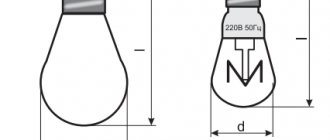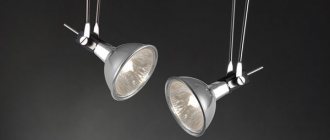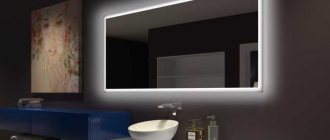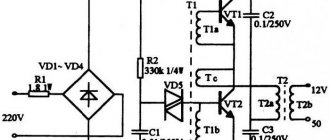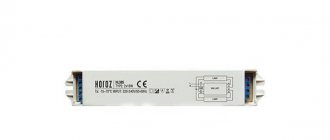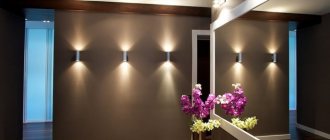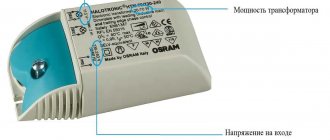With rising prices for electrical energy, consumers are increasingly switching to economical and energy-saving lighting devices. The duration of operation of the lamp before it fails, as well as the quality of its glow, also play a major role in savings. Due to these characteristics, halogen lamps have become the most popular.
Device and principle of operation
The filling of halogen light bulbs is in many ways similar to incandescent filaments: the same glass bulb, filament body and base. However, these light sources contain iodine and bromine.
Passing through the filament body, the current heats up the tungsten filament, which leads to glow. Due to the high temperature, tungsten atoms are released, which interact with halogens (iodine and bromine). The reaction prevents the deposition of metal elements on the inner walls of the lighting device, which can significantly increase the life of the light bulb.
Thus, the operating principle of a halogen light bulb is based on the use of a tungsten-halogen cycle:
- Evaporation of tungsten.
- Transport of particles by diffusion or convection to areas of lower temperature.
- The appearance of stable molecules of tungsten and halogen compounds.
- Transporting the emerging molecules to areas with high temperatures - to a heated tungsten spiral.
- The decomposition of molecules as a result of exposure to elevated temperature and the release of tungsten atoms onto the surface of the luminescent body.
The processes described above reduce the impact of two key disadvantages of standard incandescent light bulbs:
- The body of the flask does not darken, since the evaporated tungsten particles return to the filament.
- The glow body is regenerated, which increases the service life of the light bulb.
At the same time, the tungsten-halogen cycle is not without its disadvantages:
- Reactions where iodine is used are impossible without an oxygen environment. Since hydrogen compounds (methyl iodide and methylene) are used as fillers, a water cycle is carried out in the flask, accelerating the destructive processes in the filament.
- Iodine does not allow the filament to be completely regenerated, since the return of tungsten atoms occurs in a chaotic manner. In this case, the most overheated areas of the glow body are not restored. The consequence is the rapid evaporation of tungsten from areas exposed to critical temperatures and burnout of the filament.
- The disadvantages of using iodine also appear in other matters: aggressiveness when interacting with metals, absorption of a considerable part of the radiation in the green-yellow part of the spectrum. There is also an insufficiently developed halogen dosing technique.
The listed disadvantages are compensated by the use of other types of halogens. For example, bromine compounds (ethyls and ethylenes) have recently become widespread. It is also possible to use fluorine or chlorine. Fluorine is especially interesting, since it is most effective in enhancing thread regeneration. A significant limiting factor for bromine, fluorine and chlorine is their aggressiveness.
Application
Despite the fact that halogen light bulbs are inferior in efficiency to LED and fluorescent light sources, they are popular. In particular, 220 V lamps with dimmers easily replace standard incandescent light bulbs.
Halogen devices are used as lighting for cars. This light source is ideal for this area because it provides high light output, long service life, resistance to voltage surges, and has a small bulb. Halogen lamps are also used in spotlights, ramps, and for lighting during photography and video filming. They are used in silk-screen printing and flexographic printing, when drying materials that are sensitive to ultraviolet radiation.
Halogen light sources are used as heating elements. We are talking about using them in electric stoves, microwave ovens and blowtorches.
Types of halogen light bulbs
Halogen light bulbs are classified according to power sources:
- low-voltage version with 12 Volt driver;
- incandescent lamps 220V.
The classification of lamps is shown in the figure below.
Low voltage light bulbs can also be connected to a dedicated 220V power supply, but only if a step-down transformer is provided. This device reduces the voltage to an acceptable level (12 Volts). Halogen bulbs of this type have a pin base G4, G9, GU10, G12. The H4 type base is also used in the automotive industry.
Types of bases are shown in the following figure.
Light bulbs are usually divided into several types depending on the features of their design:
- linear;
- capsule;
- with reflector;
- with a remote flask;
- low voltage;
- halogen chandeliers;
- IRC halogen light sources.
Linear
The production of halogen light sources began with this type of light bulb. Such lamps are still produced today. Linear light sources have a pair of pin holders on both sides of an elongated bulb. For domestic purposes, such devices are rarely used due to their high power (from 1 to 20 kW).
Capsule
Such light bulbs are characterized by their small dimensions. Capsule light sources are used to illuminate interiors. Typically G4 and G9 sockets are used. As for G9, this base is designed for a 220 V network. Due to their compactness and low power, capsule devices are often installed in open-type luminaires.
With reflector
Halogen light bulbs with reflectors are also called directional light bulbs. A similar effect is achieved through the use of a reflector, which is made in one of two options - interference or aluminum. In the case of an aluminum reflector, heat is dissipated forward, while the interference design involves dissipation of heat to the rear. Also, devices with a reflector are made with or without a protective cover. Lamps with a reflector are equipped with different types of bases: for a 220 V network or low-voltage ones for 12 Volts.
With a remote flask
External bulb devices are often confused with standard incandescent bulbs. They have a similar design, including an E14 or E27 threaded base, the same glass bulb and filament body. But inside a light bulb with a remote bulb there are halogens.
Halogen chandeliers
Light sources of this type are produced with E17 or E27 socket. One of the main characteristics of chandeliers is the small size of the bulbs; they are almost invisible. Chandeliers are usually designed to operate on a 220 V network, but low-voltage lamps are also available. In the latter case, you will need to connect through a step-down transformer.
Note! To avoid overheating, it is recommended to use ceramic cartridges instead of standard cartridges.
Low voltage
Low-voltage light sources include devices operating on 6, 12 or 24 Volts. The most common option is a 12 Volt lamp. Most often, low-voltage halogen light bulbs are used when installed on flammable substrates. They are used for lighting interiors (spot lighting), small fragments of garden plots, for illuminating exhibits in museums, etc.
Due to their safety, low-voltage light sources are approved for use in rooms with high humidity levels. But in this case, it is necessary to ensure reliable protection of the base from water getting on it.
Note! Low-voltage devices are always connected to the mains via transformers.
IRC halogen lamps
Halogen IRC lamps have a special coating that is transparent to visible light, but is a barrier to infrared radiation. This coating receives infrared light and reflects it back to the spiral. Thanks to this technology, heat losses are reduced and the lamp efficiency is increased. According to the leading manufacturer, Orasm, the technology can reduce electricity consumption by 45% compared to other halogen light bulbs. At the same time, the service life of the device increases by 2 times. The IRC lamp allows you to get a powerful luminous flux of 1700 lm, as well as a light output of 26 lm/W, which is twice as high as possible with a 35-watt fluorescent light source.
Installation of lamps
Planning the lighting system in the room should begin before installation work begins. To install halogen lamps, it is recommended to provide 7-10 cm between the ceiling and the suspended (stretch) ceiling.
All materials located near installed lamps must be heat-resistant, since halogen light sources are prone to overheating. The same applies to the lampshade.
The step-down transformer is installed directly under the ceiling. This is possible due to the compactness of this device. After installation, the transformer is hidden under drywall or tension covering. Several connections to one transformer are allowed. However, its power should be slightly greater than the total of all consumers connected to it.
It is recommended to route wires under the ceiling using special branch boxes. They are installed so that if necessary (during repairs) there is unhindered access to them. The cable is then directed to the area where the lighting fixture is attached.
The wires are laid in a corrugated pipe. It acts as a protective barrier against mechanical damage.
Installation in suspended ceiling
The work is performed in this order:
- Before assembling the ceiling structure, the surface is marked. At the same time, marks are made of the places where the lamps will be installed.
- Next, using a crown, drill a round hole in the box.
- Wires are pulled through the hole.
- The conductor is connected to the lighting fixture using spring clips.
- Once the cable is secured, the suspended ceiling can be installed. The lamps are installed after finishing the finishing touches in the room.
Advice! If during the installation process you accidentally touch the lamp with your bare hand, you must wipe the lamp with a dry napkin or lint-free cloth.
Installation in a suspended ceiling
Installing lamps in a suspended ceiling is done a little differently. The body of the lighting fixture is not fixed to the canvas (it simply won’t support it), but to the reinforcement on the concrete base.
Installation procedure:
- Mount the frame for the suspended ceiling.
- Wiring is being done.
- Fixing reinforcement is installed to the concrete base at marked locations. The mount is a compact plastic box or ring on durable legs.
- Attach a fixing ring to the reinforcement.
- Stretch the ceiling covering.
- Feel for the location of the fastening ring. The thermal insulation ring of the retainer is brought to the ring (directly through the fabric). Make a hole in the canvas.
- Pull the wiring out and connect to the lighting device.
- Secure the lamp with clamps to the fittings.
The process of installing lamps in a suspended ceiling is simple, but requires skill and accuracy. Therefore, in the absence of experience, it is better to entrust such work to specialists.
Specifications
To choose the right halogen light bulb, it is recommended to delve into their key technical characteristics. This will enable you to select a device with suitable light intensity, power and input voltage.
Basic characteristics:
- A type of base. There are many types of bases, including G4, G9, GU10, G12 and others. Taking into account the type of base, other parameters are chosen (in particular, this determines whether the lamp will be open or closed).
- Power supply voltage. There are two options, one of which is designed for power supply from a 220 V network, the second - for 12 Volts.
- Power. This parameter depends on the type of light bulb. For linear light bulbs, a parameter of 100-1,500 W is used; for low-voltage capsule light sources with a G4 holder, 10 W, 20 W or 35 W are used. For a G9 holder you will need 40 W, and for light bulbs with a reflector - 20.35 or 50 W.
- Flask shape. It is made in the form of a candle and can be linear or pear-shaped.
- Type of luminous flux.
- Colorful temperature. Halogen bulbs provide a comfortable temperature for the eyes, ranging from 2.7–3 thousand K.
- Color rendering index. This indicator is around 100.
- Light bulb service life. On average, the light bulb will work for 2 thousand hours. If operating conditions are ideal, a halogen light source can work twice as hard.
- Efficiency. Usually in the range of 50–80%. The low rate is associated with energy consumption for heating the surface of the product.
The following figure shows the main types of bases.
Note! As soon as voltage is applied, the light comes on instantly. The higher the wattage of the bulb, the brighter the lighting will be.
The lamp markings are shown in the figure below.
Advantages and disadvantages
A properly organized lighting system involves the use of the most suitable lamps. To figure out which type of light bulb is more suitable for a particular situation, it is recommended to familiarize yourself with their characteristics. This will highlight the pros and identify the cons of different lighting devices.
Advantages of halogen light bulbs:
- high level of color rendering, regardless of modification, due to which the most reliable colors are achieved - without serious distortion;
- sufficient light intensity;
- affordable prices;
- long service life;
- a wide selection of modifications that differ in many parameters (voltage, base, power, etc.).
The figure below shows a comparison of different types of light sources.
Halogen devices also have disadvantages (especially for household light bulbs):
- instability to voltage changes in the electrical network;
- sensitivity to regularly occurring switching;
- fragility of the structure.
Number of lumens
Preheat the samples for 5 minutes until the light flux stabilizes. A photometric sphere is used to measure light. We use Osram Original H4 as a sample of a standard lamp; all others will be compared with it.
| Name | Near | Further | Difference |
| 1. PIAA Hyper Arros +120% H4 | 1080lm | 1650 lm | +3% / 0% |
| 2. Koito Whitebeam III Premium H4 | 960 lm | 1600 lm | -9% / -4% |
| 3. Fukurou F1 H4 | 1390 lm | 2050 lm | +32% / +23% |
| 4. Philips Racing Vision +150 H4 | 1200 lm | 1640 lm | +14% / -2% |
| 5. Osram Night Breaker Laser +150 H4 | 1150 lm | 1610 lm | +10% / +4% |
| 6. General Electric Megalight Ultra +150 H4 | 1210 lm | 1700 lm | +15% / +2% |
| 7. Bosch Gigalight plus 120 H4 | 1120 lm | 1650 lm | +7% / 0% |
| 8. Champion +90 H4 | 780 lm | 1470 lm | -25% / -12% |
| 9. Osram Original H4 | 1050 lm | 1670 lm | — |
| 10. GSL Standard +30% H4 | 1080 lm | 1690 lm | +3%/ 0% |
The Japanese Fukurou F1 are in the lead with a short-range result of +32%, a long-range result of +23%. The rest have a maximum of +15% on low beam, +4% on high beam. The luminous flux is practically no different from standard halogen bulbs, so there cannot be any +150%.
Features of operation
To maximize the life of a halogen light bulb, it is recommended to avoid touching the bulb with bare hands. Even on clean hands there is a layer of fat, which, when it comes into contact with the surface of a light source, leads to an imbalance in temperature, blackening of the bulb and burnout of the light bulb. Therefore, any manipulations with a halogen lamp should be performed not with bare hands, but with the help of a napkin or lint-free cloth.
Another way to increase lamp life is to avoid turning the light on and off too often. It is better for a lamp if it works for several hours without interruption than if it is turned on and off several times during this period. Stable input voltage also extends service life.
Safety precautions
Before installing or replacing a halogen lamp, review safety precautions. It will help avoid mechanical failure and overheating of the device. Follow the disposal rules, because... There is a buffer gas inside the light bulb.
Why shouldn't you touch the halogen lamp with your hands?
On a budget halogen lamp, fingers can leave greasy stains. The temperature on them can exceed the permissible limit. But in expensive models, a double bulb protects the lamp from melting and burning out.
Fig. 10 – consequences of installation without gloves.
If the integrity of the device is compromised, this will lead to immediate failure or reduced service life.
Proper disposal
Damaged or broken light bulbs should be disposed of properly. Halogen lamps should not be thrown away with household waste because of the harmful volatile vapors in the bulb. They do not pose a serious danger, however, experts advise collecting damaged products in a separate container and handing them over to special collection points. Their location can be found on the Internet.
How to properly replace a light bulb on a car
Manufacturers
The most famous company specializing in the production of halogen lamps is Osram. Its assortment includes light bulbs of any variety and power. On sale are capsule lamps, devices with a reflector, with classic bulbs and much more. In addition to light sources for household use, Osram produces lamps for cars.
There are other manufacturing companies, the most famous of which are Navigator and Camelion. Prices for products of this kind vary greatly depending on the type of light bulb, its technical capabilities and the reputation of the manufacturer. 20 V light bulbs cost from 40 rubles per unit, and 150 V lamps cannot be purchased for less than 400–500 rubles.
Marking
The marking of halogen lamps for the CIS countries is as follows:
- the first letter is the material used to make the flask (“K” means quartz);
- the second letter is the name of the gas in the flask (if “G” is halogen, if “I” is iodine);
- the third letter – design features (“M” - small-sized);
- the first group of numbers is the operating voltage in Volts and, separated by a hyphen, the rated power in Watts;
- the last digit is the product revision number (difference from the base model).
Explanation of markings
Tips for choosing
To choose the right lighting for your home, you need to take into account a number of circumstances:
- Power and light output. Halogen bulbs have a higher ratio than incandescent bulbs. If a regular light bulb creates a light flow of 12 lm, then a halogen light bulb produces 25 lm. Accordingly, for the same lighting intensity you need a halogen bulb with half the power.
- Voltage. Low voltage devices consume less electricity. In addition, they are small in size. However, to use them you will need a transformer, since direct connection to the network is not technically possible.
- Module power. The indicator is calculated taking into account the total power of light sources. For three light bulbs with a power of 50 W each, you need a 150 W transformer. Underload is acceptable, but not more than 15 W.
- The wire. You will need a wire with a cross-section of 1.5 square millimeters. The optimal option is 2.5 square millimeters.
- Light regulator. A special device for low-voltage halogen devices is selected.
- Base. For each light bulb there is a corresponding type of base.
Note! The base for installing the light source must be made of fireproof materials. To protect the plasterboard base, a special ring is enough, but in the case of a suspended ceiling, you cannot do without a thermal platform.
How and which driver to choose for g4 12v LED lamps
Navigator power supply
A driver, also known as a power supply/power supply/step-down transformer, is required to convert 220 V household voltage to 12 V.
There are two types of drivers:
- delivering direct current (suitable for LED operation);
- producing constant voltage (suitable for LED strips and low-voltage light bulbs).
You can read more about drivers in the article “What is a driver and why do LEDs need it?”
For 12 V LED lamps you need a second type: a constant voltage unit.
To select a driver, you need to know two parameters: the total output power of the light sources in the chandelier (just add up all the powers and multiply by a safety factor of 1.2) and the output voltage of the power source. In our case, this is 12 V. Knowing these two parameters, you can select a power supply.
As additional selection parameters, it is recommended to pay attention to the protection class of the power supply. The higher the IP, the better.
Most often, LED manufacturers also produce drivers. It is best to choose a device from a well-known and reliable manufacturer.
- Related Posts
- What is duralight, connection and installation
- What types of LED strips are there and how to choose them
- Quartz lamp for home disinfection
Self-connection
Installing a halogen lamp with your own hands is not difficult. The work should be done with gloves or hold the transparent part of the device with a napkin or piece of cloth. The outer bulb is less sensitive, but it is still better to use gloves.
Lamps with reflectors are mounted to a stand with a mounting ring. Tendrils or springs are used as a fastening element (the specific method of fixation depends on the model). The fastener provides mechanical fastening of the device in the mounting ring.
A dedicated wire is connected to the light bulb. Daisy chain connection is allowed. However, this method is undesirable, as it leads to loss of power.
Pulse cables are used because they provide compactness. The phase conductor from the box is connected to the switch, and the wire from the switch is connected to the transformer. The zero is directed from the junction box to the transformer. The device is screwed into the base in the same way as a regular incandescent lamp.
